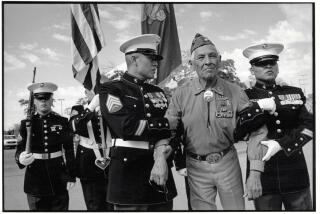Horace Bristol; Pioneering Photojournalist
- Share via
OJAI — Pioneering photojournalist Horace Bristol, who chronicled the Dust Bowl migrants John Steinbeck later wrote about in “The Grapes of Wrath” and who became one of Life magazine’s first photographers, has died at the age of 88.
Bristol died Monday at Ojai Valley Community Memorial Hospital of cancer.
“Horace Bristol was one of the most important photographers of his generation,” famed Life magazine photographer Alfred Eisenstaedt once said. “His photographs must be seen and remembered.”
Yet Bristol and his work were all but forgotten until the mid-1980s. His photography career was a story of two distinct lives.
In the first, he was a globe-trotting photojournalist whose images landed on more than a half-dozen covers of Life. He also worked for Fortune and National Geographic, covering royalty and movie stars as well as the pain of the Depression-era migrants who fled to California’s Central Valley in the 1930s.
While living in San Francisco, he was a friend and neighbor of such giants of photography as Ansel Adams, Edward Weston and Imogen Cunningham.
During World War II he joined Edward Steichen’s renowned U.S. Naval Photographic Unit, creating indelible images of America at war.
Yet that career skidded to a halt in 1956, when he was living in Japan and his first wife committed suicide, and a grief-stricken Bristol destroyed much of his huge collection of negatives and pictures and gave up photography for a life as a “frustrated architect.”
After living in Mexico, he returned to the U.S. to live in Ojai in 1968 with his second wife, Masako, and their two children. But he would not emerge into the public eye again until the mid 1980s, when his son, Henri, preparing a book report for high school, innocently asked Bristol if he had ever read “The Grapes of Wrath.”
“He realized he had completely neglected to share that part of his life with his children when in fact he had . . . interviewed migrant workers with Steinbeck,” Henri Bristol said Tuesday. “His perspective was telling stories with images and I think he got a kick that people regarded it as art at all.”
Indeed, when Bristol decided to put a few of his pictures on the auction block in the late 1980s, he was astonished to discover they brought about $1,500 apiece.
“I hate to be mercenary,” he told The Times in 1989. “The pictures were just as good when I thought they were worth $100, but from that time on I’ve had a little more respect for my work.”
Others’ respect for his work continued to grow as well, with critics lauding his bold composition and strong eye.
His work became the subject of retrospectives in galleries from New York to Los Angeles, his surviving 38 “Grapes of Wrath” images attracted the attention of the Smithsonian, and Microsoft founder Bill Gates’ CORBIS purchased the digital rights to the 16,000 negatives he was still painstakingly cataloging at the time of his death.
Bristol’s most treasured pictures were those of rural Korean life that he shot while living in postwar Japan; his son plans to publish them in a book.
Bristol was born in Whittier on Nov. 16, 1908.
Journalism ran in his blood--his father was a Los Angeles Times Linotype operator, his mother a reporter for Hearst’s Herald-Express. Bristol was a night copyreader for The Times after graduating from Belmont High School.
He grew up in rural Santa Paula with his grandfather, who owned the town’s newspaper. Bristol himself owned a small newspaper in the tiny community of Piru during the early years of the Depression.
More to Read
Sign up for Essential California
The most important California stories and recommendations in your inbox every morning.
You may occasionally receive promotional content from the Los Angeles Times.













